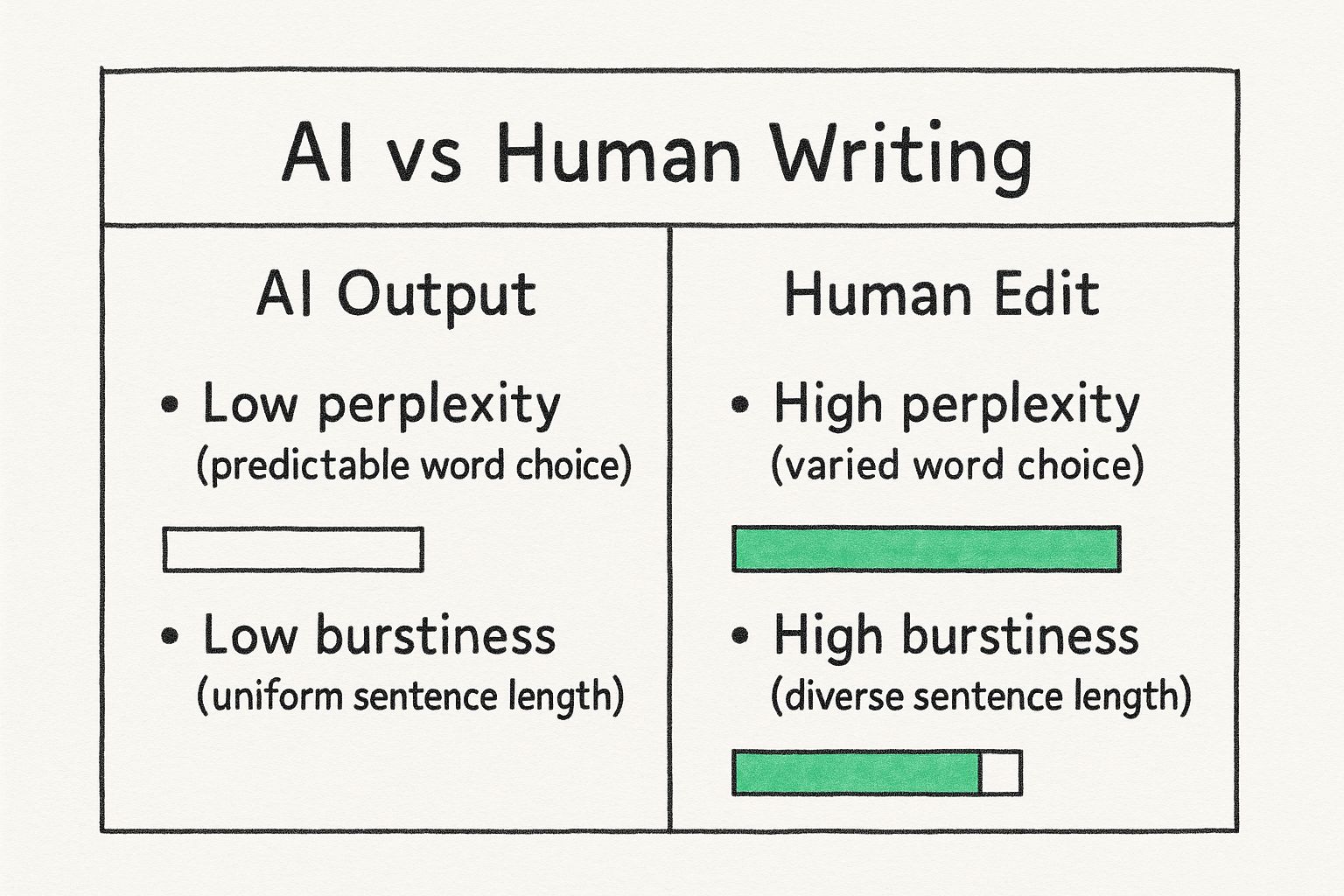A Practical Guide to Rewriting AI Text to Sound Human

If you want to effectively rewrite AI text to sound human, you have to do more than just swap out a few words. It’s about injecting your unique voice, weaving in personal stories, and playing with sentence structure. This is how you turn a robotic first draft into an authentic piece that connects with your readers and avoids AI detection.
Why Your AI Content Needs a Human Touch

AI writing tools are fantastic assistants, but you are still the pilot. The raw text they generate often feels stiff, misses the emotional heart of a topic, and can be easily flagged by increasingly sophisticated AI detectors. This is where you, the human expert, come in to add the finishing touches.
Learning how to rewrite AI text to human isn't just a "nice-to-have" skill anymore—it's essential for content creators, marketers, and students. It’s what separates content that builds trust from content that falls flat. Without this crucial editing step, you risk publishing impersonal articles that fail to make a real connection with your audience.
The Problem with Unedited AI Text
You’ve probably seen it before. The tell-tale signs of unedited AI are hard to miss: repetitive sentence patterns, a generic tone, and a complete absence of personality. These machine-generated quirks can instantly drown out your brand's voice, making your content sound exactly like a million others.
The scale of this challenge is growing. Recent statistics show that while 64.7% of marketers used AI in 2023, that number is expected to jump to a massive 90% by 2025. While AI offers incredible speed, the rising demand for human rewriting proves that quality and authenticity are what truly matter. You can dig into more of these stats on HumanizeAI.com.
The goal isn't just to sneak past an AI detector. It's to create content that is genuinely helpful, memorable, and showcases your unique expertise.
Here at PureWrite, we believe that smart, human-led editing is the secret to making AI's efficiency work for you. This guide will provide a practical framework for turning sterile, machine-written text into something compelling and undeniably human. We're here to help you refine your message, not replace your voice.
For more hands-on tips, check out our guide on how to improve English writing skills.
Ready to feel the difference? Give PureWrite a try and see how easily you can humanize your AI-generated content.
Understanding the AI Writing Footprint
Ever wondered how AI detection tools can spot machine-written content? It’s not magic; they're trained to recognize specific digital fingerprints left behind by AI language models.
The two biggest giveaways are technical concepts known as low perplexity and low burstiness.
Perplexity and Burstiness: The AI Giveaways
Let's break those terms down into simple language. Perplexity measures how predictable a text is. AI models are designed to choose the most statistically likely next word, which often results in safe, generic phrasing that lacks creative spark.
Burstiness, on the other hand, is all about sentence variety. Humans naturally mix it up—we use short, snappy sentences for impact and follow them with longer, more descriptive ones. AI often struggles with this, producing text where every sentence is roughly the same length and structure, creating a monotonous, robotic rhythm.
To give you a clearer picture, here’s a quick breakdown of what to look for in your drafts.
AI vs Human Writing Characteristics
| Characteristic | Typical AI-Generated Text | Authentic Human Writing |
|---|---|---|
| Word Choice | Predictable, common, and statistically safe. | Creative, surprising, and often uses idioms. |
| Sentence Structure | Uniform length and rhythm; feels repetitive. | Varied mix of short, long, and complex sentences. |
| Flow & Rhythm | Monotonous and flat. | Natural and dynamic, with peaks and valleys. |
| Overall Feel | Lacks personality and a distinct voice. | Expressive, engaging, and full of personality. |
This table highlights the core challenge: AI output is often just too perfect and uniform.
The infographic below offers a great visual comparison of these traits. You can see how the AI's output is flat and even, while the human writing is much more dynamic and varied.

As you can see, the key to humanizing AI text is to consciously break these predictable patterns. You need to inject the beautiful chaos that defines real human communication.
Your goal isn't just to swap out a few words. It's to dismantle the robotic structure and rebuild it with a natural, human rhythm.
This is exactly what we built PureWrite to do. Our algorithm doesn't just paraphrase; it intelligently restructures sentences and introduces the necessary variety to make your text feel genuinely human. If you want to dive deeper, check out our guide on finding the best AI text humanizer.
Ready to erase those AI fingerprints? Try PureWrite now and transform your robotic text into compelling, human-sounding content.
A Practical Guide to Humanizing Your AI Content

Alright, this is where the magic happens. To truly rewrite AI text to human, you need a strategy that goes beyond simple word-swapping. The goal is to mold a functional draft into something that actually resonates with your audience.
Your work starts before you even ask the AI to write. Spend time creating detailed, specific prompts. Tell it about your target audience, the exact tone you're aiming for (e.g., professional, witty, empathetic), and the style you prefer. A little effort upfront saves a ton of editing headaches.
Find Your Voice and Inject It
Once you have the AI's first draft, it's time to make it yours. This step is non-negotiable. AI text, by its nature, is generic; it lacks the personal flair that builds a genuine connection with your audience.
The easiest way to do this is by weaving in personal stories or real-world examples from your own experience. An AI can state facts, but it can't tell the story of how you helped a client double their traffic or share a lesson you learned the hard way. These personal touches are what make your content unique and valuable.
Powerful content doesn’t just state facts—it creates a connection. Your personal stories and unique insights are what an AI can never replicate.
For instance, an AI might say, "SEO is important for visibility." You can transform that into something much more compelling: "I'll never forget the time a small tweak to our SEO strategy doubled a client's organic traffic in just three months. That’s when the critical importance of visibility truly clicked for me." See the difference?
Polish the Rhythm and Flow
AI-generated text often has a very predictable, almost robotic rhythm. Your job is to break that up by creating a more natural, conversational cadence. You can achieve this by consciously varying your sentence structure.
Here are a few actionable tips:
- Use Active Voice: Instead of "The report was written by the team," try the more direct "The team wrote the report." It’s more energetic and clear.
- Ask Rhetorical Questions: Pull your readers in by asking things like, "So, how can you apply this?" It interrupts the flow in a good way and encourages engagement.
- Keep It Simple: Ditch the corporate jargon and overly complex words. Opt for simpler, clearer language that everyone can understand.
These refinements are especially crucial in academic writing, where clarity is everything. For a deeper dive, check out our guide on how to improve academic writing.
It's no surprise that while 71% of marketers use AI for brainstorming, the real value is added in the human-led rewriting stage. You can read more about these AI writing trends and statistics to see just how essential the editing process has become.
We built PureWrite specifically for this. It's designed to help you instantly adjust the tone, smooth out awkward phrasing, and humanize your text with a click. Try PureWrite today and feel the difference.
Beyond the Basics: Creating Content That Truly Connects
This is where you move from a good editor to a great writer. Moving past simple corrections and into the art of the rewrite is what separates good content from unforgettable content. It’s all about infusing your work with a genuine human touch that AI simply cannot replicate.
To do this, you have to bring unique value to the table. Consider weaving in unique data you've gathered, quoting an industry expert, or sharing a personal anecdote. These are the details that build trust and position your content as a truly valuable resource.
Shattering the Robotic Mold
If you really want to rewrite AI text to human, you have to consciously break free from its predictable patterns. AI tends to play it safe, often avoiding the very language that makes human writing so compelling.
Don't be shy about using idioms, metaphors, or a well-placed cultural reference. For example, a student could use this in an essay to make a point more memorable, or a marketer could use it in a blog post to connect with their audience. These elements make your writing feel grounded and relatable.
Powerful content does more than just state facts—it inspires and persuades. This happens when the language is not only clear but also emotionally resonant.
For example, an AI might generate, "The new marketing strategy was very effective." You could easily elevate that to something with more personality, like, "The new marketing strategy absolutely knocked it out of the park." It’s a small change, but it makes a world of difference in tone and impact.
Your Final Sanity Check
Before you publish, do one last pass to make sure your work is as polished and human as possible. A quick checklist can be your best friend here, helping you catch any lingering robotic traces.
- Sentence Rhythm: Do your sentences flow naturally? Look for a healthy mix of short, punchy statements and longer, more detailed sentences.
- Verb Power: Have you replaced weak, passive verbs with strong, active ones? Dynamic language is crucial. Our guide on action verbs vs linking verbs is a great place to start.
- Personal Stamp: Is there a unique anecdote, a specific example, or an opinion in the piece that is unmistakably yours?
This final layer of polish is often what makes the difference. Try PureWrite and see how our tool helps you create content that truly stands out.
Using AI Ethically and Authentically
As AI tools become a regular part of our work, we must focus on using them responsibly. If you want to build and maintain trust with your audience—whether they're customers, professors, or colleagues—you cannot skip the human element.
The single most important ethical step is to fact-check everything your AI assistant generates. AI models are known for "hallucinating"—making up facts and sources with absolute confidence. Your oversight is critical to protecting your credibility.
Think of AI as a capable assistant, not a replacement for your expertise. At PureWrite, our philosophy is built on the idea that AI should support human creativity. It's there to help you overcome writer's block and work more efficiently, but you are always the final author and authority.
Finding the Sweet Spot Between Speed and Originality
Being transparent and prioritizing originality is what ultimately provides real value to your readers. This isn't just a nice idea; the data backs it up. Recent studies show that only 44% of users are satisfied with the quality of raw, unedited AI content.
That number tells a clear story. It highlights a massive quality gap that can only be filled by a skilled human editor who understands nuance, tone, and audience needs. You can discover more about these AI content trends to see why authenticity is making a comeback.
Ultimately, using AI ethically means you take full ownership of what you publish. You are the final authority, ensuring every word is accurate, authentic, and genuinely helpful.
When you pair the speed of AI with your unique expertise, you get the best of both worlds. For a more detailed breakdown, we encourage you to check out our guide on ethical AI practices.
Ready to put this balanced approach into action? See how PureWrite can help you rewrite AI text to human without the hassle.
Your Questions About Humanizing AI, Answered
As creators, professionals, and students integrate AI into their workflows, many of the same questions come up. It's completely normal to wonder about the best way to rewrite AI text to sound human. Let's clear up a few of the most common ones.
Can AI Detectors Really Spot AI-Generated Content?
Honestly, no AI detector is perfect. They are trained to recognize the tell-tale signs of machine writing, like repetitive sentence structures and a lack of creative flair. They are essentially playing a game of probabilities.
When you step in and perform a proper human edit, you break those predictable patterns. You can vary sentence lengths, add a personal story, or adjust the tone. This makes the content far less likely to be flagged because it no longer fits the robotic mold the detectors are looking for.
Is It Okay to Use an AI Rewriter for My Work?
Think of AI as a very capable assistant, not the final author. Using it to brainstorm ideas or generate a first draft is a smart and widely accepted practice for marketers and content creators. However, simply passing off raw AI output as your own is where ethical lines can get blurry, especially in academic or professional settings.
The best practice is to treat the AI draft as a starting point. It’s on you to do the real work: reshape it with your voice, double-check every fact, and weave in your unique insights. Always be sure to check your company or school’s specific policies on using AI tools.
How Does Humanizing AI Content Help with SEO?
Google's main goal is to serve up genuinely helpful content created for people. A machine can't fake real-world experience. When you rewrite an AI draft, you're adding the very things Google values most: original data, expert quotes, or personal stories.
This directly contributes to what SEO professionals call E-E-A-T (Experience, Expertise, Authoritativeness, and Trustworthiness). Furthermore, content that feels human keeps people reading longer. Better engagement sends strong, positive signals to search engines, telling them your page is a valuable resource worth ranking higher.
Ready to put this into practice and ensure your content truly connects with your audience? With PureWrite, you can take robotic first drafts and polish them into something compelling and authentic. Give our AI text humanizer a try today at https://purewrite.io.